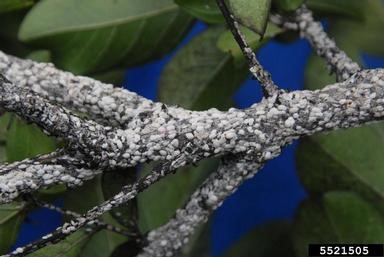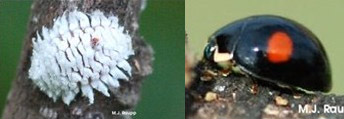Crape Myrtle Bark Scale on Crape Myrtle Trees
by Elaine Pugh, Fairfax Master Gardener

Heavy infestation of Crepe Myrtle Bark Scale
Crape myrtle bark scale (CMBS), a type of felt scale, is a serious threat to the crape myrtle, Lagerstroemia indica. We first reported this to you as a new pest to Virginia in 2017. CMBS has continued to spread.
The crape myrtle is a commonly-used flowering, small-leafed, multi-trunked specimen tree or shrub in the South that comes in all sizes and shapes from a large vase shaped tree to a small shrub. Profuse flowers in the summer are found in various shades of red, pink, white and lavender. The fall colors of yellow, orange or red add color to the landscape. Smooth, exfoliating bark also adds to its beauty in the winter to give it a four-season use in the landscape.
The technical term for crape myrtle bark scale may be labeled as either Acanthococcus lagerstroemiae or Eriococcus lagerstroemiae. It is a type of invasive felt scale from Asia related to the azalea bark scale and oak eriococcin scale. According to Virginia Tech Extension, female CMBS can lay several hundred pink eggs when mature. The eggs hatch into pinkish mobile crawlers, which move onto new areas of the plant before settling down as sessile nymphs. Sessile CMBS develop increasingly denser coverings of whitish waxy material as they develop. Nymphs molt into wingless adult females or, after a “pupal” stage, into winged adult males. In Virginia, CMBS appears to have at least two generations per year. (Texas A&M University shows a chart of the generation cycles.)

Crape Myrtle Bark Scale and sooty mold
Fluffy, white and gray, tiny bumps appear on the bark and twigs. As the infestation progresses, it covers the plant with a black sooty mold. Sooty mold is a black fungus that grows on honeydew, the excrement of aphids and scales. As compared to soft or hard scales, these scales feel like felt when touched. Pinkish red fluid runs out when scales are crushed.
Early identification and control is best. Look with a magnifying glass for CMBS on your crape myrtles where it first attacks in the crotches of branches and trunks, around old pruning scars, under the loose bark and on small twigs and branches in the upper part of the tree. Continue monitoring your crape myrtles for CMBS on a regular basis and start treating if needed.
The crape myrtle aphid also causes sooty mold but does not have scales.
CMBS was first discovered on crape myrtle trees in the United States in the Dallas/Fort Worth area in 2004, probably on an infested nursery stock import, and has been rapidly spreading. It reached Mississippi in the spring of 2015, North Carolina in August 2016, and Virginia Beach, VA in January of 2017. CMBS is now found throughout the southeastern US, extending into the Mid-Atlantic and the lower Plain States, including multiple areas of eastern Virginia.(Texas A&M University shows a map of the states affected.)
Long distance infestation comes from unknowingly planting a purchased infected plant or by improperly removing a plant already infected. Once on a tree, the scale can spread by wind, or by crawlers in contact with birds, flying insects, small animals or people. Heavy infestations may also extend to the leaves and to nearby low-growing plants, grass and mulch. Once in an area, it spreads rapidly from tree to tree, even when trees are hundreds of feet apart.
According to the North Carolina Forest Service, CMBS can cause considerable damage to crape myrtle trees, including stunted growth, branch dieback, reduced flowering, and can limit photosynthesis capabilities. Virginia Tech Extension adds that crape myrtles infested with CMBS tend to leaf out later in the spring; have fewer, smaller bloom clusters; and have reduced plant vigor, all of which stresses the trees. It does not kill the tree, but it is very unattractive and weakens the tree.
How to discourage this pest
- Inspection. Inspect plants for felt scale before purchase and avoid it.
- Selection. Plant a different tree for plant diversification.
- Plant Location. Plant crape myrtles in full sun, which discourages establishment of CMBS.
- Fertilizing. Do not apply too much nitrogen fertilizer, which may encourage scale populations.
Methods of treatment
- There is no one-time cure-all to permanently rid a crape myrtle tree of CMBS, so treatments must be reapplied each year.
- Naturally occurring predators
The good news is that, according to Virginia Cooperative Extension, a new beneficial ladybird beetle, Hyperapis begeminata, has emerged in some areas that can drastically reduce CMBS infestations. Examine infested plants for ladybird beetles feeding on CMBS. Adult Hyperapis begeminata are small, shiny, domed black beetles with two red spots. Immatures of this ladybird beetle are covered with a white fluffy covering and are often mistaken for CMBS. However, the beetle larvae will move when disturbed, unlike adult CMBS. - Soil-applied insecticide

Larvae and Adult Hyperapis begeminata, ladybird beetle, a predator of crapemyrtle bark scale
In Virginia, the most effective chemical control is a soil drench of the systemic imidacloprid or dinotefuran. The best time to apply this is after the leaves begin to come out in the spring, usually around April. These treatments take several weeks to work, moving up into the plants, and give control for about a year. Do not apply insecticides when pollinators or predatory ladybird beetle adults or larvae are present. See the Mississippi State Extension link for more detailed information on how to apply this. If effective, the scales will become dry and not ooze pinkish red when scratched with a fingernail. Note that all insecticide/pesticide users are required by law to follow the usage directions on the container.
- Horticultural oils or insecticidal soap
These options may be only mildly effective. More details are provided on the Virginia Cooperative Extension website link. For this option, consider lightly pruning flower clusters and branches heavily infested with CMBS before spray treatments. This reduces the tree’s attractiveness to other insects such as pollinators, physically removes large numbers of the pest and allows for better coverage of the interior of the tree. - Physically scrubbing it off
For any control method, the sooty mold will still remain unless removed. Heavier accumulations on the main trunks can be lightly scrubbed off with a bristle brush and mild dish detergent in water, to kill and remove CMBS. According to Mississippi State Extension, this will improve the aesthetics of the tree and make it easier to monitor the long-term effectiveness of the treatment program provided above. However, washing alone will not stop it. - Remove it
Mississippi State Extension states that when destroying infested plants or pruned branches, it is important to do so in a manner that will prevent spread of scale to nearby crape myrtles. Burning or placing infested plants in a landfill where they are promptly buried are suggested methods of plant destruction and disposal. Trucks and trailers used to haul away infested plant material must be tightly tarped to prevent wind-blown spread to other crape myrtles located along the route to the disposal site. - Foliar Contact Spray with Insecticide
Please note that the previous treatment option of a foliar contact spray with an insecticide has been deleted for homeowners due to concerns with possible damage to the bee population since crape myrtles are such long-flowering trees. Both Texas A&M University and Mississippi State Extension discuss the addition of crawler sprays with insect growth regulators in addition to soil-applied systemic insecticide treatments for more aggressive control but limit its use to licensed professional applicators.
References
• Crapemyrtle Bark Scale, by Theresa A. Dellinger, Eric Day, Alejandro Del-Pozo, Virginia Tech
• Crape Myrtle Bark Scale Identification and Control, by Dr. Blake Layton, Jr., Mississippi State
University
• Crapemyrtle Bark Scale, Mike Merchant, Mengmeng Gu, Texas A&M University
• New scale insect threatens the South’s beloved crape myrtle, by NC Forest Service